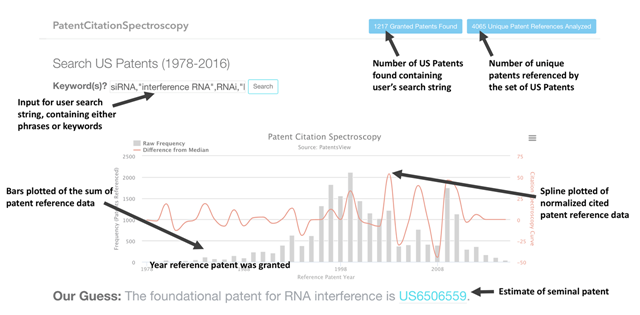FW: [scisip] Algorithmic retrieval of landmark patents; prprint version
Glenn Hampson
Here’s a fun new tool for you patent fans out there (Loet is on the OSI list if you wanted to ask questions).
From: Science of Science Policy Listserv [mailto:SCI...@LISTSERV.NSF.GOV] On Behalf Of Loet Leydesdorff
Sent: Saturday, October 14, 2017 8:11 AM
To: SCI...@LISTSERV.NSF.GOV
Subject: [scisip] Algorithmic retrieval of landmark patents; prprint version
Patent Citation Spectroscopy (PCS): Algorithmic retrieval of landmark patents
Jordan A. Comins[1],*,‡, Stephanie A. Carmack[2], and Loet Leydesdorff[3]
htttp://www.leydesdorff.net/comins/pcs
https://arxiv.org/abs/1710.03349
Abstract
One essential component in the construction of patent landscapes in biomedical research and development (R&D) is identifying the most seminal patents. Hitherto, the identification of seminal patents required subject matter experts within biomedical areas. In this brief communication, we report an analytical method and tool, Patent Citation Spectroscopy (PCS), for rapidly identifying landmark patents in user-specified areas of biomedical innovation. PCS mines the cited references within large sets of patents and provides an estimate of the most historically impactful prior work. The efficacy of PCS is shown in two case studies of biomedical innovation with clinical relevance: (1) RNA interference and (2) cholesterol. PCS mined and analyzed 4,065 cited references related to patents on RNA interference and correctly identified the foundational patent of this technology, as independently reported by subject matter experts on RNAi intellectual property. Secondly, PCS was applied to a broad set of patents dealing with cholesterol – a case study chosen to reflect a more general, as opposed to expert, patent search query. PCS mined through 11,326 cited references and identified the seminal patent as that for Lipitor, the groundbreaking medication for treating high cholesterol as well as the pair of patents underlying Repatha. These cases suggest that PCS provides a useful method for identifying seminal patents in areas of biomedical innovation and therapeutics. The interactive tool is free-to-use at: www.leydesdorff.net/comins/pcs/ .
[1] *corresponding author; Social and Behavioral Sciences Department, The MITRE Corporation, McLean, VA, United States; jco...@gmail.com
‡ The author's affiliation with The MITRE Corporation is provided for identification purposes only, and is not intended to convey or imply MITRE's concurrence with, or support for, the positions, opinions or viewpoints expressed by the author. Approved for Public Release; Distribution Unlimited Case #17-0951.
[2] National Institute on Drug Abuse, National Institutes of Health, Baltimore, MD, 21224
[3] Amsterdam School of Communication Research (ASCoR), University of Amsterdam, PO Box 15793, 1001 NG Amsterdam, The Netherlands

########################################################################
To send to the list, address your message to: SCI...@listserv.nsf.gov
To subscribe to the list: send the text “subscribe SCISIP” to list...@listserv.nsf.gov
To unsubscribe: sent the text “unsubscribe SCISIP” to list...@listserv.nsf.gov
